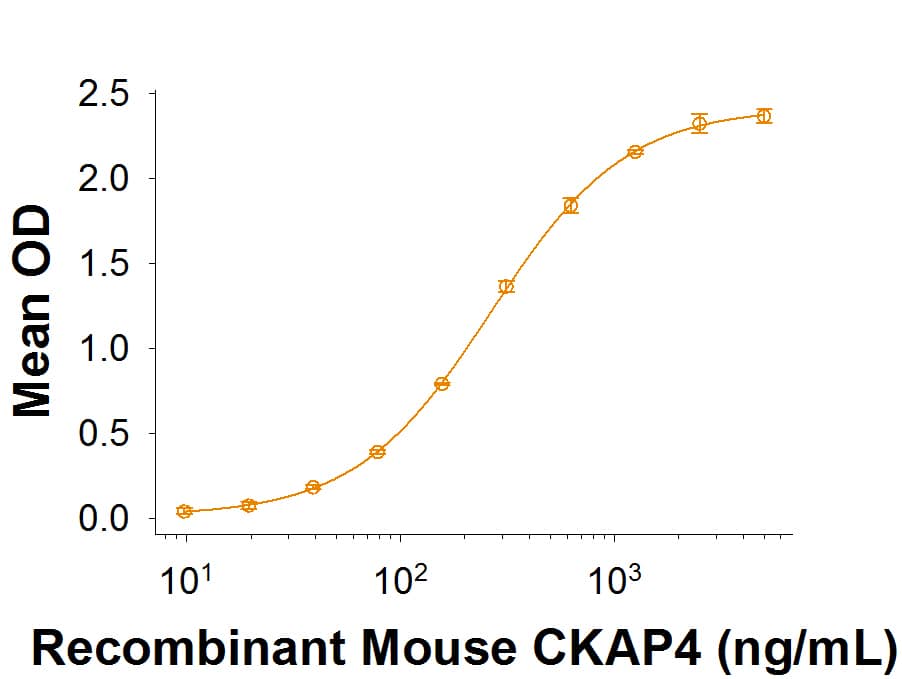Recombinant Mouse CKAP4/p63 Protein, CF
R&D Systems, part of Bio-Techne | Catalog # 9734-CK

Key Product Details
Product Specifications
Source
Mouse myeloma cell line, NS0-derived mouse CKAP4/p63 protein
Val109-Ile575, with an N-terminal 6-His tag
Val109-Ile575, with an N-terminal 6-His tag
Purity
>95%, by SDS-PAGE visualized with Silver Staining and quantitative densitometry by Coomassie® Blue Staining.
Endotoxin Level
<0.10 EU per 1 μg of the protein by the LAL method.
N-terminal Sequence Analysis
His
Predicted Molecular Mass
53 kDa
SDS-PAGE
45-59 kDa, reducing conditions
Activity
Measured by its binding ability in a functional ELISA.
When Recombinant Mouse Dkk‑1 (Catalog # 5897-DK) is immobilized at 1 μg/mL (100 μL/well), the concentration of Recombinant Mouse CKAP4/p63 that produces 50% of the optimal binding response is 35-280 ng/mL.
When Recombinant Mouse Dkk‑1 (Catalog # 5897-DK) is immobilized at 1 μg/mL (100 μL/well), the concentration of Recombinant Mouse CKAP4/p63 that produces 50% of the optimal binding response is 35-280 ng/mL.
Scientific Data Images for Recombinant Mouse CKAP4/p63 Protein, CF
Recombinant Mouse CKAP4/p63 Protein Binding Activity
When Recombinant Mouse Dkk-1 (Catalog # 5897-DK) is immobilized at 1 µg/mL (100 µL/well), Recombinant Mouse CKAP4/p63 binds with an ED50 of 35-280 ng/mL.Formulation, Preparation and Storage
9734-CK
| Formulation | Lyophilized from a 0.2 μm filtered solution in PBS. |
| Reconstitution |
Reconstitute at 500 μg/mL in PBS.
|
| Shipping | The product is shipped with polar packs. Upon receipt, store it immediately at the temperature recommended below. |
| Stability & Storage | Use a manual defrost freezer and avoid repeated freeze-thaw cycles.
|
Background: CKAP4/p63
References
- Bates, S. R. et al. (2008) Am J Physiol Lung Cell Mol Physiol, 295:L658.
- Gupta, N. et al. (2006). Am J Physiol Lung Cell Mol Physiol 291:L436.
- Razzaq, T. M. et al. (2003). J. Biol. Chem. 278:42679.
- Schweizer, A. et al. (1994). J. Cell Biol.126:25.
- Huttlin, E. L. et al. (2010) Cell 143:1174.
- Planey, S. L. et al. (2009). Mol Biol Cell. 20:1454.
- Conrads, T.P. (2006) J Bio Chem, 281:49.
- Matika, C.A. (2012) Mol Bio Cell, 23:10.
- Shahjee, H.M. (2010) J Exp and Clin Cancer Res, 29:1.
- Kazi, A.S. (2010) Am J Physiol Lung Cell Mol Physiol 299:6.
- Kimura, H. et al. (2016) J Clin Invest, 126:2689.
Long Name
Cytoskeleton-associated Protein-4/Climp-63
Alternate Names
CLIMP-63, ERGIC-63, p63
Gene Symbol
CKAP4
UniProt
Additional CKAP4/p63 Products
Product Documents for Recombinant Mouse CKAP4/p63 Protein, CF
Product Specific Notices for Recombinant Mouse CKAP4/p63 Protein, CF
For research use only
